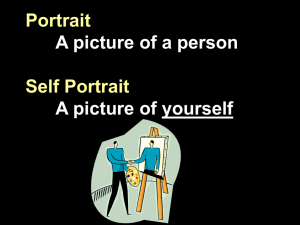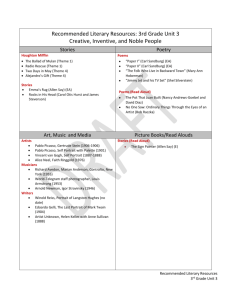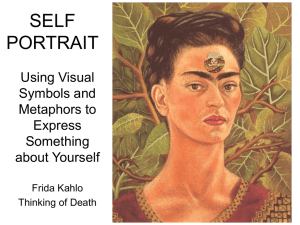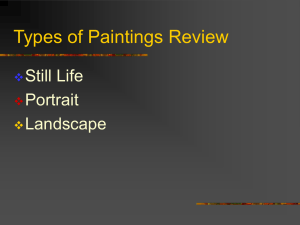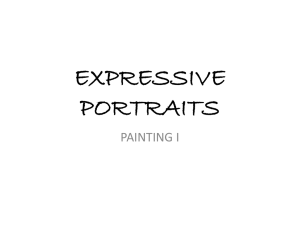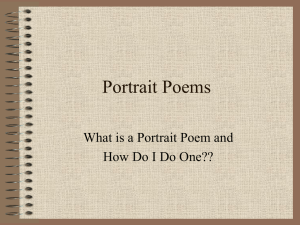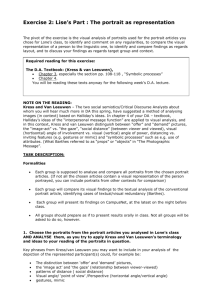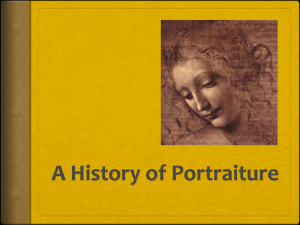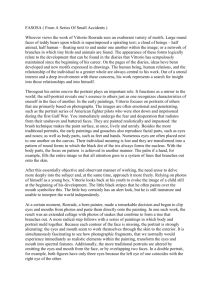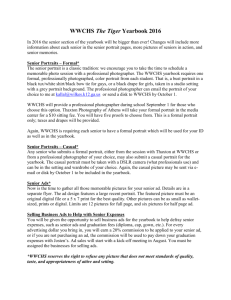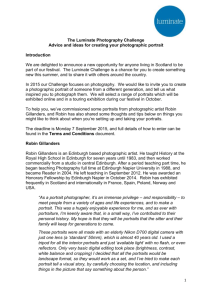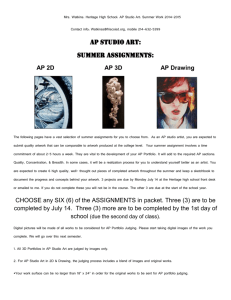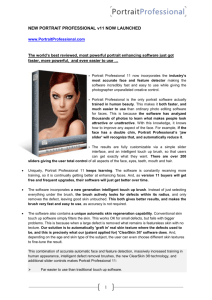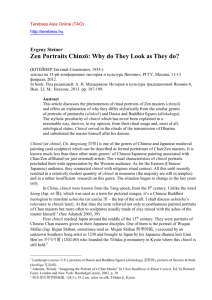Lesson Plans from Jen W. The Memory Project
advertisement
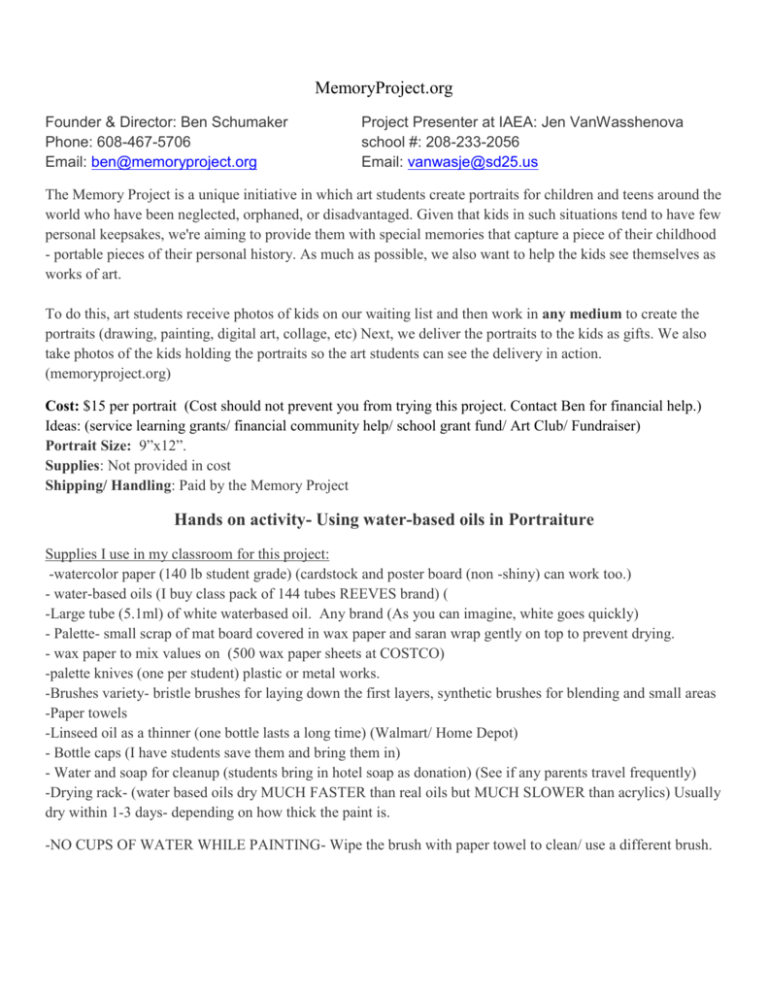
MemoryProject.org Founder & Director: Ben Schumaker Phone: 608-467-5706 Email: ben@memoryproject.org Project Presenter at IAEA: Jen VanWasshenova school #: 208-233-2056 Email: vanwasje@sd25.us The Memory Project is a unique initiative in which art students create portraits for children and teens around the world who have been neglected, orphaned, or disadvantaged. Given that kids in such situations tend to have few personal keepsakes, we're aiming to provide them with special memories that capture a piece of their childhood - portable pieces of their personal history. As much as possible, we also want to help the kids see themselves as works of art. To do this, art students receive photos of kids on our waiting list and then work in any medium to create the portraits (drawing, painting, digital art, collage, etc) Next, we deliver the portraits to the kids as gifts. We also take photos of the kids holding the portraits so the art students can see the delivery in action. (memoryproject.org) Cost: $15 per portrait (Cost should not prevent you from trying this project. Contact Ben for financial help.) Ideas: (service learning grants/ financial community help/ school grant fund/ Art Club/ Fundraiser) Portrait Size: 9”x12”. Supplies: Not provided in cost Shipping/ Handling: Paid by the Memory Project Hands on activity- Using water-based oils in Portraiture Supplies I use in my classroom for this project: -watercolor paper (140 lb student grade) (cardstock and poster board (non -shiny) can work too.) - water-based oils (I buy class pack of 144 tubes REEVES brand) ( -Large tube (5.1ml) of white waterbased oil. Any brand (As you can imagine, white goes quickly) - Palette- small scrap of mat board covered in wax paper and saran wrap gently on top to prevent drying. - wax paper to mix values on (500 wax paper sheets at COSTCO) -palette knives (one per student) plastic or metal works. -Brushes variety- bristle brushes for laying down the first layers, synthetic brushes for blending and small areas -Paper towels -Linseed oil as a thinner (one bottle lasts a long time) (Walmart/ Home Depot) - Bottle caps (I have students save them and bring them in) - Water and soap for cleanup (students bring in hotel soap as donation) (See if any parents travel frequently) -Drying rack- (water based oils dry MUCH FASTER than real oils but MUCH SLOWER than acrylics) Usually dry within 1-3 days- depending on how thick the paint is. -NO CUPS OF WATER WHILE PAINTING- Wipe the brush with paper towel to clean/ use a different brush. Water Based oil portrait Process: Step 1: Get a color photo or black and white reference photo (8.5”x11” is good) (Memory Project will send you quality color photos to use and will also send you the electronic file if you want to print black and whites) Step 2: On a heavier paper (see supply list) have students draw out the portrait. (Tape onto a board to fit in the drying rack) (Since most of the lines will disappear quickly once oil goes on, I usually let my students trace the contours of the portrait with carbon tracing paper which is reusable. This step saves so much time and ensures a more accurate looking portrait. (I still spend about 2 days prior to this lesson going over the human head/ planes/ shapes/ proportions etc..) Proko on Youtube has great demos to help you Step 3: Squeeze about a nickel size of paint onto your palette. (Sienna brown, black, white, cad red, yellow, yellow ochre, ultramarine blue, etc…) Step 4: On a separate piece of wax paper, have students mix about 4-5 values that they see within the portrait. Lights to darks (skin tone only) Get the 4-5 tones pretty close to the actual color. Step 5: Use a darker value- brownish blue to establish darks. Within the pupils(black), nostrils, center line/ inside of mouth. These darks can blend and fade into your skin tones. Now, use your bristle brush, start quickly laying down the values where you see them. Quick shapes of values. Step 6: Once most of the face is covered, take your synthetic brushes and LIGHTLY blend the 2 values next to each other. DO NOT OVER BLEND. Wipe your brush with paper towel after 1-2 blending strokes. Step 7: Add additional highlights/ darks where needed. Step 8: Paint background (some students use acrylics for the background) Let dry. Paint clothing. (I encourage the background and clothing to get creative by using the person’s interest. Ex: Child wants to be a police officer, so the artist can add a police cap and police uniform (collar and badge). Background could be blends of red, white, and blue. Etc… ) Step 9: Final touches and small signature if they choose. Let completely dry to prevent smearing. Ta Da!! Name and Hour: RESEARCH FOR MEMORY PROJECT- INDIA 1. What is the size of India in comparison to the United States? 2. How do Indians bury their dead? Different ways depending on the region and tradition. 3. One Million Indians are millionaires however, what is the poverty percentage? How much money does the typical Indian earn per day? 4. Why are cows considered sacred in India? What is a tilak? 5. List at least 5 different languages that are spoken in the country of India. 6. India is the birthplace of what board game? __________________________ 7. The meaning of the Indian flag colors are: Saffron means_________________________ White means__________________________ Green means__________________________ 8. What is India’s national animal?_________________________ 9. What are the religions found in India (most common) _________________,________________,_______________ 10. What did Mohandas K. Gandhi (1869-1948) do for India? 11. What flower is sacred to Hindu’s and Buddhists? 12. What is the routine before and during meal eating? 13. What is the traditional color to wear to a funeral in India?__________________ 14. Who was the Taj Mahal built for? How many years did it take to finish it? Name: Date: Hour: The Memory Project: Final Reflection 1. Imagine that you have been abandoned, orphaned, or neglected and are growing up without parents to call your own. What might that be like? 2. What do you think the portrait you made will mean to the child/ teenager receiving it? 3. Does coming “face to face” with this young person through a photo make you feel like you have a personal connection of any kind? Why or why not? 4. If you had one million dollars to use for helping kids in these situations, how would you use the money and why? 5. When trying to create positive change in the world, we don’t always see “proof” that our efforts are making a difference. If you don’t see that photo “proving” that the child loved your gift, will you still feel satisfied with your effort? 6. When you think of kids in situations like this, what do you feel grateful for in your own life?

